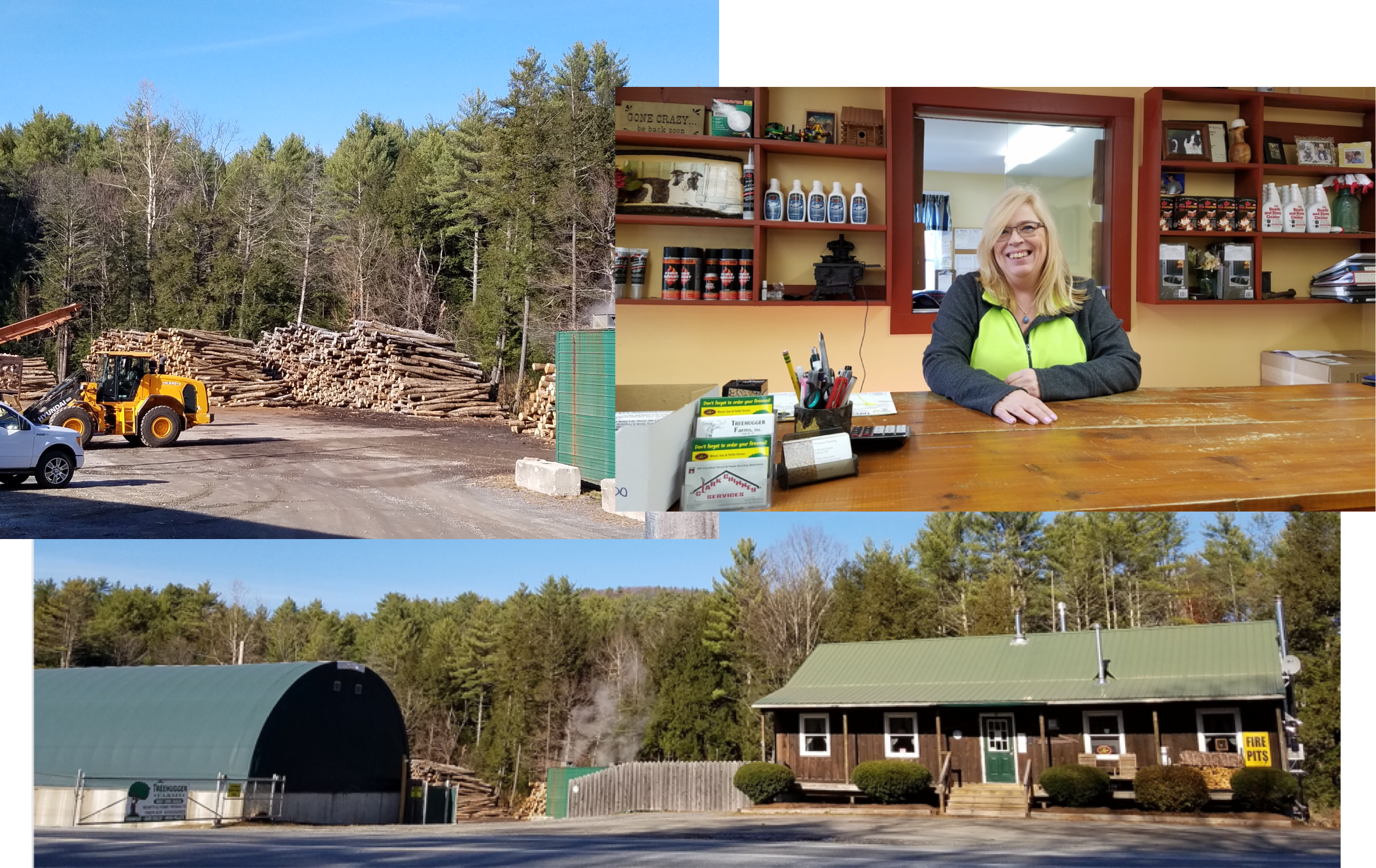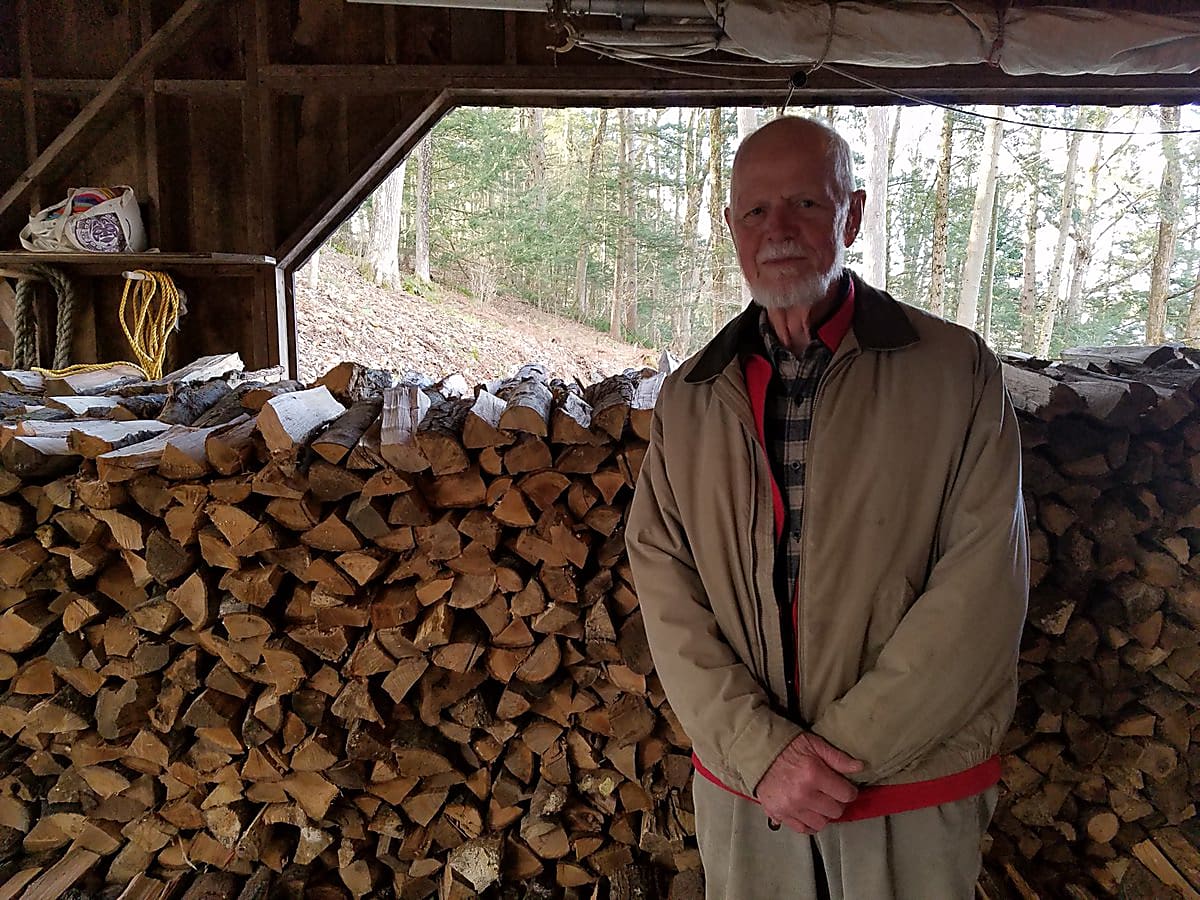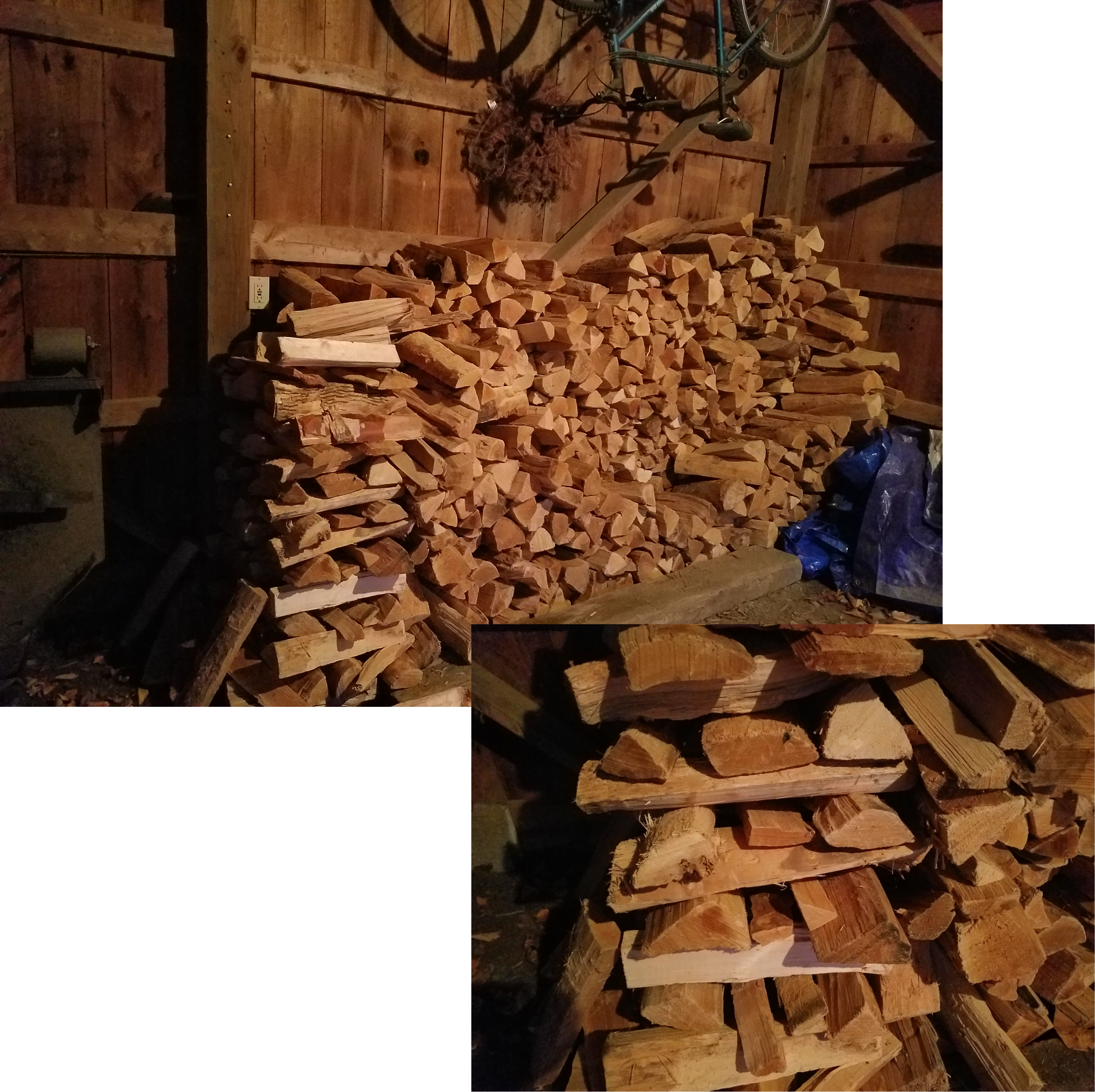How to Stay Warm in New Hampshire Winters
Everything you need to know to get ready for winter. With 2023 updates.

Planning on a move to New Hampshire? Whether you're going to rent or buy, it helps to have a few tips on winter heating.
There are a surprising number of methods that New Hampshire homeowners use to heat their homes. These include:
- Firewood-based heat via wood stove or fireplace.
- Pellet stoves
- Gas stoves
- Wood or oil-fueled furnace
- Electric baseboard heating
- Radiant floor heating
My experience is with the first 4, so I'll focus on those.
Many homes use more than one source of heat. For example, a friend of mine has a wood-fueled furnace, a gas stove in the bedroom, a wood stove in the living room, and a fireplace in the kitchen.
Almost everyone has a backup source of heat: such as electric baseboard heating.
Gas Stoves
When I first moved up here my primary source of winter heat was a Vermont Castings propane-powered stove. It was set into a fireplace (See photos).
The stove was super-efficient: it was really more than was needed to heat the home.

In fact you can easily heat a 2,400 sq. ft. space with one propane stove. (Check the model you're interested in to see what square footage it's rated to heat.)
The stove was connected to a wall-mounted thermostat.
This is a great set up especially if you plan on traveling. Set the thermostat and your home will maintain an even temperature.
The stove was also not dependent on electricity: you could start it manually in the event of a power outage.

With the glass front doors on the stove, the fire looked realistic -- even the fake logs looked real.
Rest assured, you won't miss out at all on that "cozy" feeling that comes from the visual of a winter fire.
Best of all you don't have to do any schlepping or storage of firewood.
The cost of running the propane stove is going to depend on the going rate of propane.
The highest my bill got was $275/month but it typically ranged from $125- $150 to heat 750 square feet.
Mount a small fan to the side of the fireplace to better circulate the air. Ceiling fans help with this too.
Wood Stoves
I now use a wood stove as my principal source of heat. Wood stoves require a lot more work. But for some people, that's part of the fun.
You have to source good firewood, purchase it in a timely fashion, and either stack it yourself or hire someone to stack it for you.
Buying Firewood
You want to avoid being ripped off by someone who sells you "green" firewood that they pass off as ready to burn. This happened to a friend of mine in Vermont.
Tip: If you think you have green wood, check the ash level in your wood stove first. If it's built up, it can block air flow and create a condition that mimics green wood that won't burn.
Find a good source — like the town clerk — who can tell you where you can find quality firewood.
I use (and can vouch for) Treehugger Farms in Westmoreland, Cheshire County.
Oliver Wendell Holmes said it best: "Knowledge and timber shouldn't be used until they are seasoned."
At Treehugger Farms, you can buy seasoned, semi-seasoned, or kiln-dried wood (my favorite).

Treehuggers, in southwestern New Hampshire, is a great source for firewood. If you're a transplanted city slicker, don't hestitate to ask owners Jon and Donna Clark (pictured above) for fire-building tips.
Their delivery radius covers much of southwestern New Hamsphire and parts of southeastern Vermont. But, you can also pick up wood yourself at Treehuggers. Contact them for details.
Kiln-dried wood is ready to burn, and catches fire quickly. Another benefit of kiln-dried: there aren't any bugs in the wood.
That's a plus if you want to stack a good amount inside your home, as I do. I stack about 3-4 weeks' worth. That cuts down on the number of times I have to haul wood inside.
Spring is the time to purchase semi-seasoned. You need to give it a good 9 months to dry out.
Semi-Seasoned vs. Kiln-Dried
Semi-seasoned is considerably cheaper than kiln-dried. Check out Treehugger Farm's current prices.
How much firewood do I need?
- If you live in an average-sized house, count on needing 4-5 cords of firewood
- If you live in a small house, count on needing 2-3 cords.
- If you live in a small cabin, count on 1.5 cords.
- Count on spending $50 per cord if you want someone to stack it for you
How much firewood you need will be partly determined on whether you plan to rely solely on your fireplace or wood stove for heat.
Tip: Before you go to bed, put an "all-nighter" on the fire. This is simply one of the biggest logs in your stack. It won't really last "all night" but it will help maintain your heat longer.
Consider: it'll get cold in the middle of the night after your fire's gone out. Do you want to get up a few times during the night to start a new fire?
If not, you'll need to use a thermostat-controlled space heater or baseboard heating.
Realize that as late as April and May you may be running your wood stove — at least at night.
Knowing that timing is an important factor in cost of firewood should help you when planning your move.
Beware: Firewood Delivery Times Fluctuate
It's important to not expect delivery dates to remain the same year after year. They can fluctuate significantly.
Here's what I mean.
- The first year I bought firewood, there was a one-week wait for delivery.
- The second year I bought firewood — from the same source — there was a 2-month wait.
The lesson here is: don't assume. Or, assume the worst.
If you're buying kiln-dried firewood, I wouldn't wait later than September to get your first cord or two.
The only person responsible for making sure you can get the firewood you need is — you guessed it — you.
What If You're Stuck With No Firewood?
What if you get hit with a delay in delivery and snow is moving in? Well, here, Treehuggers may be a godsend.
On Saturday mornings, they usually offer self-service pickup until 1pm.
You can take a maximum of one cord. Most people simply fill up the back of their car or pickup truck, and Donna Clark (co-owner) will eyeball it when you're done to price it.
If you bring a pickup, they'll use one of their scoopers to fill your vehicle for you. Before dumping the scoop in your truck bed, they place a protective barrier against the back window
Source Kindling
You'll also need make a plan to get kindling - and an adequate amount of it.
Friends of mine gather their own kindling from the forest floor. I used to buy kindling in giant bags that a local farmer provided for sale at a nearby gas station. Then suddenly, the next year, the farmer stopped providing it.
Unlike my friends, I don't enjoy foraging for sticks in the woods. So what to do?
Typically, when the delivery truck dumps your pile of firewood there'll be a good amount of splintering that occurs, and you can get a few weeks of kindling out of that.
But it wont' be enough to last the winter.
Here are some options:
- On a self-pickup day, go to Treehuggers to get kindling.
- Also buy and use A.W. Perkins Firestarters or Rutland Firestarters. You can get these a box of 144 of these from Amazon for $22-$25. That's the cheapest price I've found. John, the co-owner of Treehugger Farms, showed me how to start a fire using just one single firestarter and some kindling. Leave your wood stove door cracked and let the fire grow gradually.
- Buy a big box of fatwood to use with your firestarters. You can get it from a hardware store or online.
Skip the Kindling Cracker. I bought one of these and it was pretty much useless.
Other options:
- You can buy a gas-powered, electric, or hydrualic log splitter to break your big logs into smaller pieces. I can't vouch for these because I haven't used them but some customer reviews say the hydraulic ones don't work on hardwood.
- Be a real Yank and use a maul to split your own firewood. (My 84-year old neighbor does this!)

My neighbor Pat, with some of his handiwork, chain-sawed and hand-split from whole logs obtained from Treehuggers. Pat prepped 5 cords of firewood this season
Firewood Delivery and Stacking
Before your firewood is delivered, you'll want to get a couple of large tarps. One is for the ground where the firewood will be dumped (in case the ground is wet) and the other is to protect the pile from rain until it gets stacked.
I mentioned that if you hire someone to stack your firewood for you, that you can count on spending about $50 for that. Realize though that you may not be able to find anyone to do this task.
Some rural communities in New Hampshire have a predominantly elderly population. So factor that into your plans.
It will be much easier to stack your firewood if you can do so in a garage, barn or tool shed where you can stack against a back wall and at least one side wall.

Working through my first cord of the 2019-2020 season. Stacking up against a wall means I only have to create a criss-cross pattern at one end.
Get an Indoor Firewood Rack
Adjustable racks are cheap: typically you'll supply two 2x4s. I have one that takes up one wall in my home.
That gives me about 3-4 weeks worth of firewood, cutting down on the number of trips I have to make to the wood pile, which is stacked in an open barn garage.
Get Your Chimney Cleaned Once a Year
In fall you'll want to get your chimney cleaned. Removing any creosote build up substantially decreases the risk of chimney fires.
And check the gasket on your wood stove. Firewood suppliers often are able to replace these for you. Expect to spend about $125 for that.
Pellet Stoves
Pellet stoves are a great option for efficiency. Like wood stoves, they're free-standing metal units that efficiently radiate heat.
The main difference is in the fuel. Wood pellets are made of pressed recycled wood waste. They look exactly like guinea pig food pellets.
You'll use a large scoop to deposit wood pellets into a tray near the top of your unit.
Like propane stoves, your pellet stove can be connected to a thermostat. When the temperature dips below a certain level, an automated mechanism will tilt the internal tray holding pellets and dump more on to the fire.
Pellets are easier to physically manage than firewood. However, you'll need to keep an eye on suppliers. Every so often, you'll hear of a plant shutting down and that can create a shortage.
Right now, $7-8 will get you a 40-lb bag of pellets. That lasts about 24 hours. Expect to need 100-150 bags to cover your winter heating needs.
For more information, visit the Pellet Fuel Institute.

You can purchase wood pellets from your local hardware store -- like Aubuchon -- or Home Depot.
Electric Baseboard Heat
My backup was (and is) electric baseboard heat. However, I'd suggest you avoid using baseboard heat if possible. It really ramps up your electric bill.
Electricity in New Hampshire costs more per kWh than the national average. (See this chart for state-by-state comparisons.)
As some have pointed out, average monthly electric bills here are below the national average. It's also true that many New Hampshire homes ration their heat (keeping temperatures at 55F or so).
Many homes here also do not have air conditioning, even though we get summer temperatures in the 90s. So I wonder if these facts play into these statistics. That, and Yankees know how to be — and enjoy being — frugal.
What About Portable Space Heaters?
If you're not using a thermostat-controlled propane stove or pellet stove, it's likely your home will be cold before morning.
You can put an "all-nighter" (a large log) into your fireplace or wood stove, but that log will burn out long before dawn.
I've tried oil-filled radiators and found these to be inefficient electricity guzzlers.
My preferred option for the bedroom is a Dr. Heater infrared quartz tube heating unit. It has a thermostat and remote control.
5 Tips For Staying Warm Outdoors
- Buy a balaclava for when the temperature hits single digits or the negatives. This style might not be fashionable, but polypropylene will sure keep your head warm.
- Get a flap-eared aviator hat (also called a bomber hat, trooper hat, or trapper hat). FurHatWorld is a good source for quality aviator hats made of real fur (rabbit, beaver, raccoon, or shearling) or fake fur. But you can get one that's probably just as warm for around $10 at your local Ocean State Job Lot (a popular discount goods store in New Hampshire).
- It ain't pretty but it works: when it gets super cold, wear your polyprop balaclava underneath your aviator hat. Your face will thank you.
- Hands and feet: In bitterly cold weather your hands can go numb walking from your front door to your car. Stock up on HotHands and keep some in your car. Get a decent pair or two of snow/ice boots. Sometimes during the spring or summer you can find top brand names available at a deep discount on Amazon. I once scored this pair of Lowa Ice boots for $67 -- they usually sell for close to $300. (Now in 2023, 7 years later, these boots are still like new.)

- When it comes to keeping your neck warm, nothing beats a double-lined Turtlefur neck fleece. In extreme cold it's nice to not have to fuss with a scarf. Plus, you can pull a Turtlefur up over your nose, balaclava style.
Local stores may not have the variety of snowboots and gear you want. So, Amazon's going to be one of your best bets. Wait until winter though, and you'll see scores of popular boot models out of stock for common sizes.